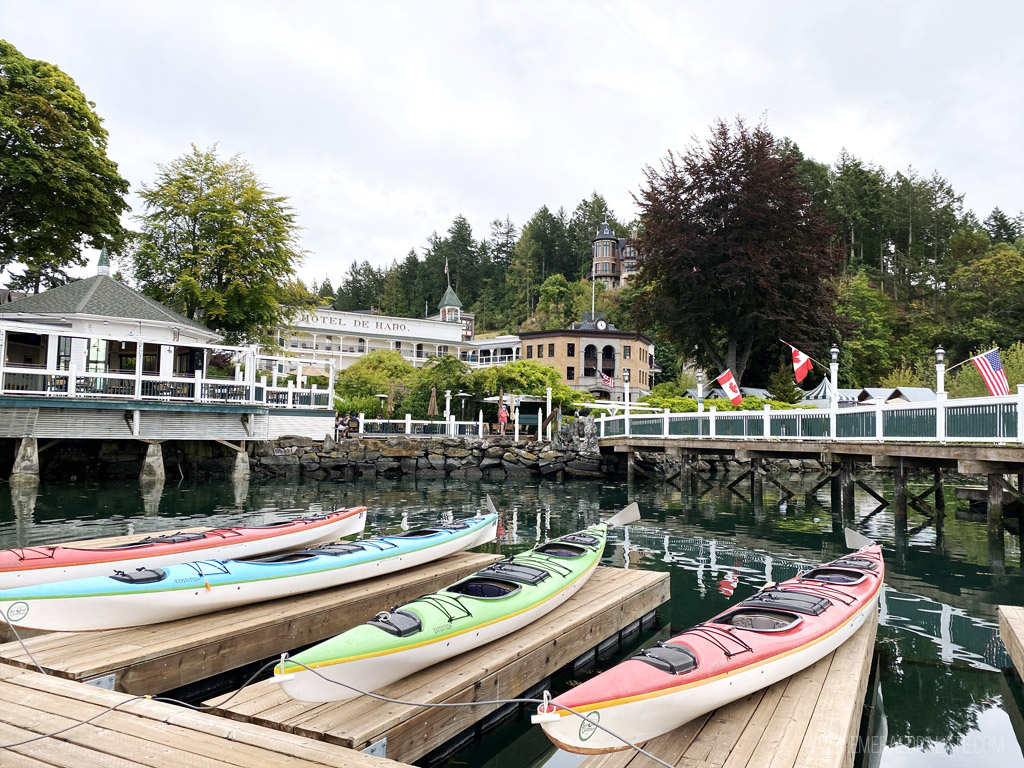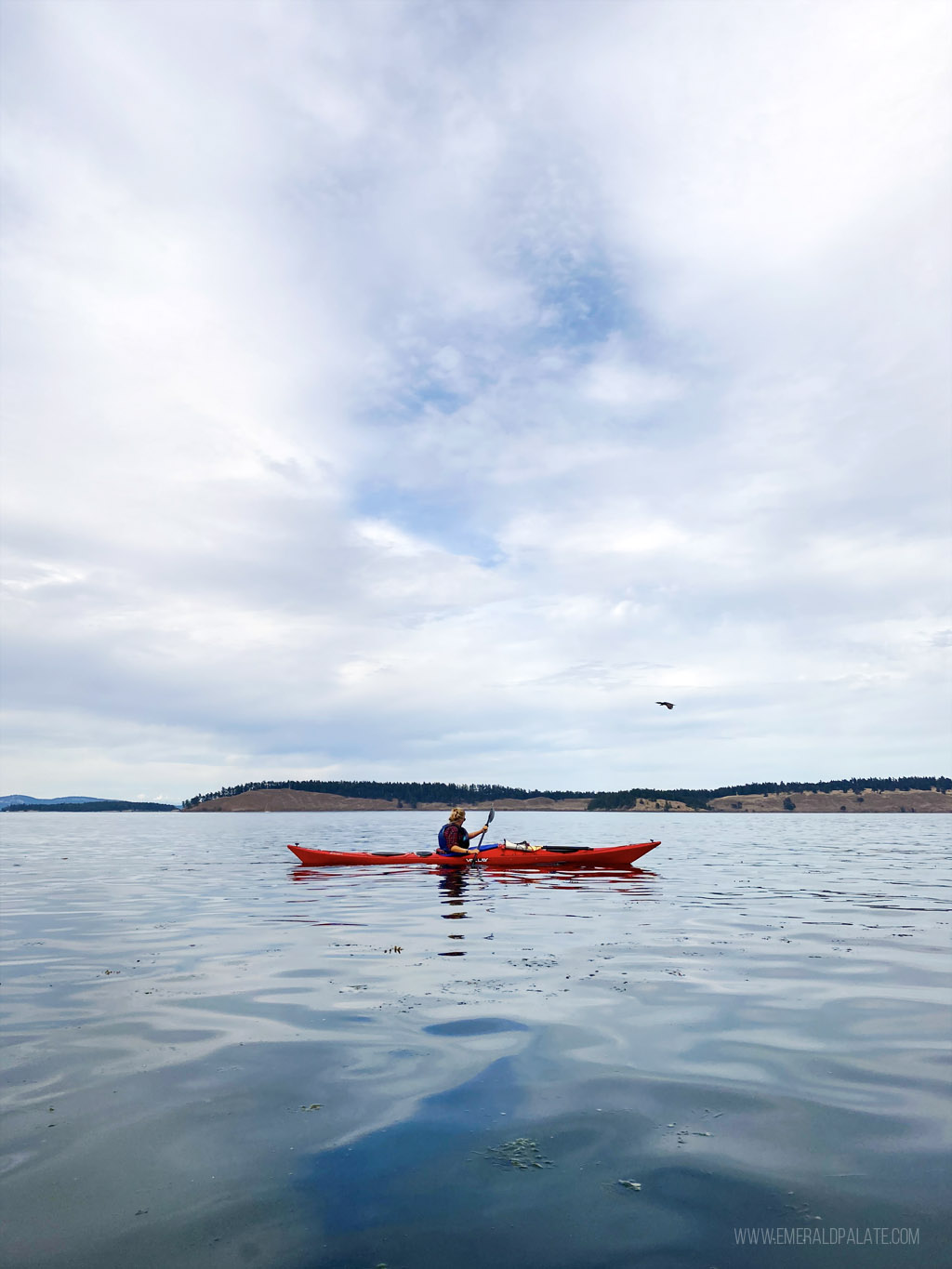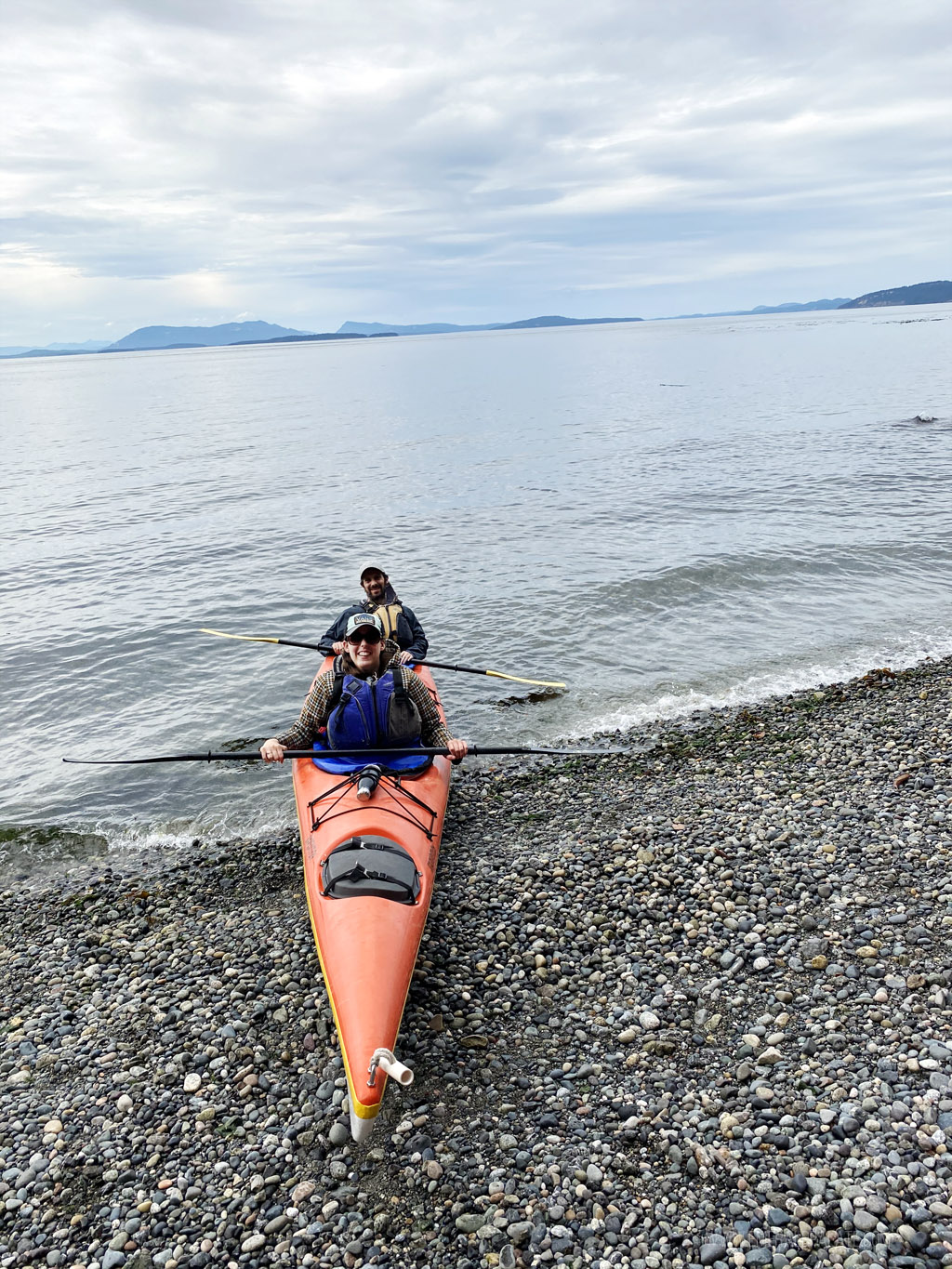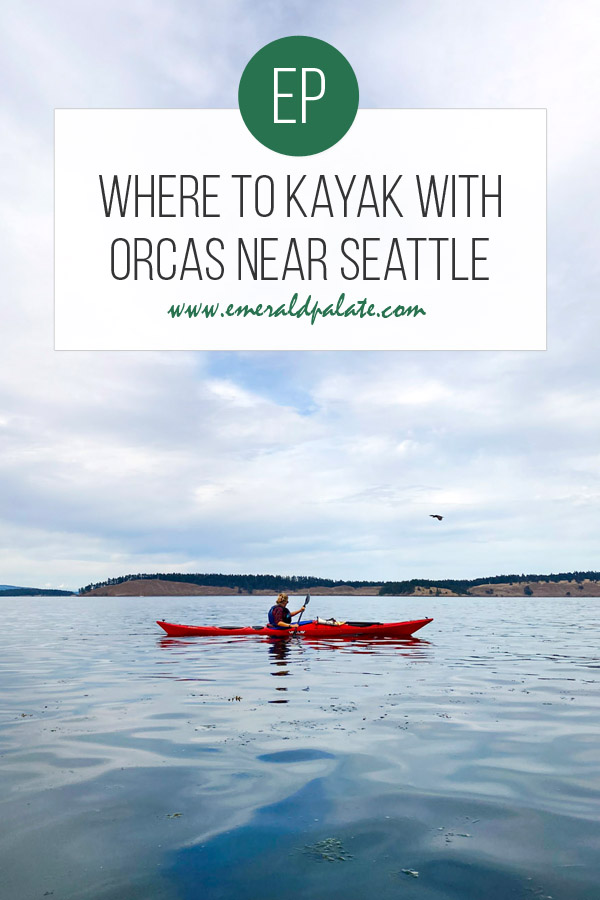
“When is the best time to kayak with orcas in Seattle” was one of the first questions I asked when I moved here more than a decade ago. The Puget Sound is home to about 72 resident orcas and even more transient ones drawn to our temperate waters teeming with salmon. Given this, the Seattle area is one of the most popular areas in the United States for whale watching.
Everyone hopes to catch a glimpse of this endangered species. And, if you’re like me, you dream of kayaking within feet of one while witnessing a full jump out of the air (preferably with mountains and a candy-colored sunset sky…hey, a girl can dream right?). Yet the chances of that happening from a kayak is slim if you don’t know the best time to go.
To help increase your chances of an orca sighting, here are all my tips and the best time to kayak with orcas in Seattle.
Best Time To Kayak With Orcas in Seattle
You can see orcas in Seattle, Washington and the surrounding areas year round. But summer between May and September are the best times to kayak with orcas. That’s because their food source, salmon, is most active around this time.
This is also the best time of year to increase your chances of seeing other types of whales. For example, the majestic humpback whale is near Seattle during the summer before migrating to Hawaii for winter. I always see humpback whales when taking a boat out to snorkel during my 5 day Maui itinerary and can attest they shouldn’t be missed!
Other wildlife you may see in summer include fin whales, minke whales, harbor seals (and maybe even seal pups in August!), stellar sea lions, dolphins, jelly fish, eagles, great blue herons, cormorant birds, and probably so many other types of birds I couldn’t even name!

Guide To Kayaking With Orcas In Seattle
Now that you know the best time to kayak with orcas in Seattle, let’s get down to all the details to increase your chances of seeing these magnificent creatures.
What to Expect
There is a high probability you will NOT see orcas from a kayak. I’m sorry to burst your bubble, but this is one of the first things I learned when doing my own research about kayaking with orcas. During my recent trip to San Juan Island, I decided to contact both the San Juan Islands Visitors Bureau and different whale watching tour operators to organize my kayaking trip.
Every single one of them said kayaking isn’t the best way to see orcas. Amy Nesler, Stewardship & Communications Coordinator of the San Juan Islands Visitors Bureau, said this:
[pullquote width=”600″ float=”center”]Guided kayak tours generally have defined routes, depending on wind, tide, and currents, and they rarely put paddlers in the vicinity of orcas.”[/pullquote]
Whale watching tours from boats, on the other hand, move at higher speeds and aren’t limited by a set path. Instead, all the tour operators are connected through a single radio and are constantly communicating about orca sightings so they can bring passengers to the whales.

However, if you do see an orca, you may experience a closer encounter. Both whale watching tour operators and kayakers need to stay 300-400 yards away from orcas, as per the Be Whale Wise guidelines. However, if an orca comes near your kayak, there’s not much you can do as a kayaker except be still. Try not to disturb them, and follow the kayaker code of conduct created by the Kayak Education Leadership Program.
How to Increase Your Chances of Seeing Orcas
To recap from above:
- Consider going on a whale watching boat tour instead of kayaking if seeing orcas is important to you.
- Make sure you go during the best time to kayak with orcas in Seattle: summer between May and September.
- Check local Facebook groups for whale sightings, such as the San Juan Whale Sightings group. This won’t help you on a tour, but if you plan to kayak with orcas on your own or they are near shore, you can rush to try and catch them.

Best Places to Kayak With Orcas
While you can see orcas right in Seattle, the best whale watching is about 3 hours north of Seattle in the San Juan Islands. This chain of more than 170 islands in the Salish Sea between Washington state and Vancouver Island is the perfect spot for them thanks to its mild weather. Because it’s in a rain shadow, it doesn’t get as much rain as other areas of Washington. This helps the water temperature stay consistent throughout the year. Which makes it an ideal home all year round for orcas.
There are 3 San Juan Islands most people visit: San Juan Island, Orcas Island, and Lopez Island. While all of them have either tour operators or options for kayaking with orca whales, San Juan Island is the most popular. That’s because it’s the western-most island where orcas like to hang. In fact, you can often see orcas from shore when visiting Lime Kiln State Park. It’s so common, in fact, its nickname is “whale watch park”.

Two other spots on the island that a local told me is good for orca sightings is Turn Point Lighthouse on Stewart Island and Shark Reef Sanctuary on Lopez Island.
How to Get to San Juan Island
I share very detailed transportation options in my guide to taking a day trip to San Juan Island from Seattle, but the gist is that you need to either drive and take a ferry or fly there.
Most people drive the 1.5 to 2 hours to Anacortes north of Seattle, then take the 1 hour ferry ride to Friday Harbor on San Juan Island. Some people use Kenmore Air, which flies to San Juan Island from Seattle for about $190 each way. There isn’t robust public transportation on the island, so it’s best to have a car if you want to go whale watching in the San Juan Islands.

Best Tour for Kayaking With Orca Whales
The last time I went to San Juan Island, I was gifted one of San Juan Outfitters’ whale watching kayak tours. I actually reached out to them asking if they wanted to partner. Because I quickly learned through internet research that most whale watching tours are not with kayaks. However, San Juan Outfitters is a member of the Pacific Whale Watch Association and offers half day, full day, and even multi-day kayaking trips!
I had a private 3-hour kayak tour that departed out of the docks of Roche Harbor on San Juan Island. In fact, San Juan Outfitters is the only tour operator with their own dock. They mentioned all the others depart from the beach at San Juan County Park. Additionally, they are one of the few whose tours operate in Roche Harbor. Most tours in the San Juan Islands depart from Friday Harbor.

Our tour guide, Hannah, was a wealth of knowledge and took us through Roche Harbor past the privately-owned Pearl Island and Henry Island (where you can hear crickets all hours of the day!). She took us onto the only public beach on Henry Island, Half Moon Bay, which has beautiful rocks and sea glass. She also answered all my questions and dropped some awesome facts.
For example, she pointed out a bald eagle’s nest. And shared how San Juan Island is the biggest eagle nesting area outside of Alaska. She also had us guess the weight of the largest nest ever found. Any guesses?

TWO TONS!
I had no idea these birds that weight just pounds could make McMansion nests like this!
Hannah also talked about San Juan Outfitters bioluminescent kayak tours. They do them once a month during the new moon, when it’s most likely you’ll see the eery blue light let off by phytoplankton in the water. I was captivated as she explained that the best time to see bioluminescence is after a few sunny days that had no wind because it lets phytoplankton charge and doesn’t disrupt the views.
What to Bring
If you go with San Juan Outfitters, they’ll offer you a kayaking skirt which covers the hole you’re sitting in and makes it very unlikely you’ll get wet while in your sea kayak. However, you should still wear clothing you’d be ok getting wet. I wore flip flops, workout pants, a t-shirt, regular under garments, and a heavy water-resistant hoodie I wear snowboarding. I didn’t get wet at all minus my sleeves from the paddle while kayaking.

Wear layers because it’ll be colder on the water. You’ll be wearing a life jacket so it may be difficult to take off said layers. But I encourage you to wear them in case it becomes too warm.
In addition to layered clothing, you’ll want to wear sunscreen, a hat, and sunglasses. I also brought a reusable water bottle and my phone. San Juan Outfitters gave us a dry bag to put things in. But I kept my phone in my jacket pocket for easy access and it was fine.
You should also bring cash to tip your tour guide!

Fun Facts About Orcas
Here is some fun knowledge dropped by Hannah, our tour operator from San Juan Outfitters, and some other facts I researched while putting together this guide on the best time to kayak with orcas in Seattle.
- Orca whales aren’t actually whales. They’re dolphins! But everyone still calls them killer whales.
- The resident whales near Seattle are called the Southern Resident Community of orcas or killer whales (SRKWs). They’re made up of the J, K, and L pods.
- Each pod uses a distinctive dialect of calls to communicate, but calls are shared between all 3 pods. Their calls are unlike the calls used by any other community of killer whales and can travel ten miles or more underwater.
- There are only 72 resident whales left in the SRKWs.
- There are only 72 whales left because of overfishing. SRKWs only eat chinook salmon, which are dying out.
- Orcas only have one baby every 8 years, which doesn’t help it’s endangered species status.
- Transient whales in the San Juan Islands don’t eat fish so they are faring better than the resident pods. They only eat mammals like seals, sea lions, and porpoises. Apparently the deer on San Juan Island can swim and these orcas also eat them!
- “Breeching” loosely means “leaving the water”, but there are many different types of breeches a whale can do and they all mean different things. Experts believe each one communicates something different.
Learn more orca facts from the Center for Whale Research.

More Places to See Wildlife Near Seattle
We’re so lucky to live in Washington state with access to water and mountains from all directions. Here are some of my favorite destinations for wildlife viewing.
- The best hikes at Mount Rainier National Park
- The Billy Frank Wildlife Refuge Near Olympia, WA
- The goats you may see while hunting for larches and fall colors
- The quaint town of Seabrook along the Washington coast








Oh, this is now on my bucket list! Thanks for all the detailed info and the great pics!
Of course, happy to help! I wish I’d had that orca breaching in the sunset shot. 😂